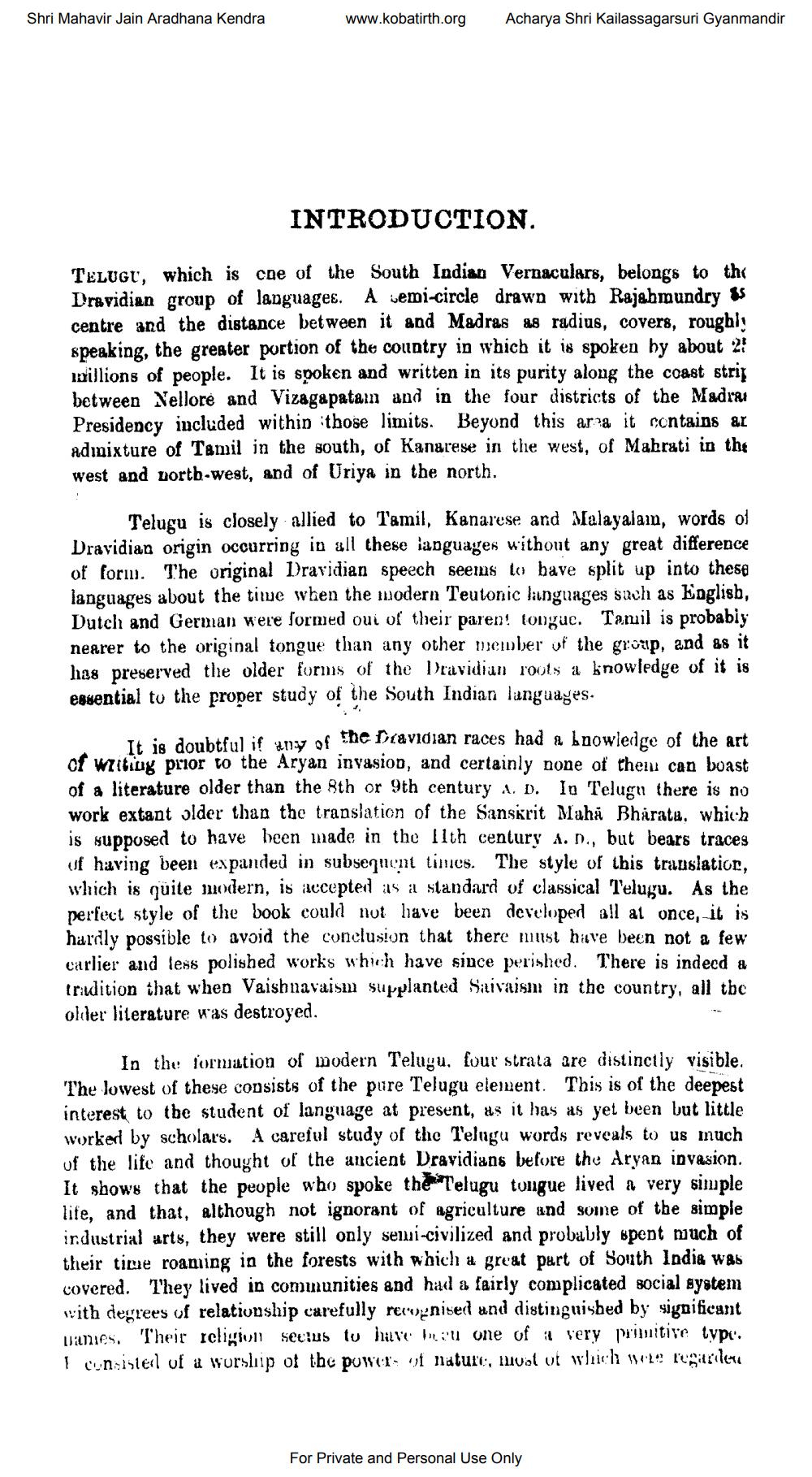Book Title: Dictionary Telgu English Author(s): Charles Philip Brown, M Venkataratnam, W H Campbell, Rao Bahadur K Veeresalingam Publisher: Asian Education Service View full book textPage 5
________________ Shri Mahavir Jain Aradhana Kendra www.kobatirth.org Acharya Shri Kailassagarsuri Gyanmandir INTRODUCTION. TELUGU, which is coe of the South Indian Vernaculars, belongs to the Dravidian group of languages. A semi-circle drawn with Rajahmundry & centre and the distance between it and Madras sus radius, covers, roughly speaking, the greater portion of the country in which it is spoken hy about 2! millions of people. It is spoken and written in its purity along the coast strip between Vellore and Vizagapatain and in the four districts of the Madras Presidency included within those limits. Beyond this ar?it contains ar adipixture of Tamil in the south, of Kanarese in the west, of Mabrati in the west and nortb-west, and of Uriya in the north. Telugu is closely allied to Tamil, Kanarese and Malayalamn, words of Dravidian origin occurring in all these languages without any great difference of form. The original Dravidian speech seems to bave split up into these languages about the time when the modern Teutonic languages such as English, Dutch and German were formed out of their paren! tonguc. Tanuil is probably nearer to the original tongue than any other member of the group, and as it has preserved the older forms of the Dravidian roots a knowledge of it is essential to the proper study of the South Indian languages. To is doubtful if y of the Dravidian races had a bnowledge of the art of writing prior to the Aryan invasion, and certainly none of then can boast of a literature older than the 8th or 9th century A. D. Io Telugu there is no work extant older than the translation of the Sanskrit Mahă Bharatu. which is supposed to have been made in the Ilth century A. n., but bears traces uf having been expanded in subsequent times. The style of this translatior. which is quite modern, is accepted as a standard of classical Telugu. As the perfect style of the book could not have been developed all at once, it is hardly possible to avoid the conclusion that there must have been not a few carlier and less polished works which have since perished. There is indeed a trudition that when Vaishnavaism supplanted Saivaism in the country, all the older literature was destroyed. In the formation of modern Telugu, four strala are distinctly visible. The lowest of these consists of the pure Telugu element. This is of the deepest interest to the student of language at present, as it has as vet been but little worker by scholars. A careful study of the Telugu words reveals to us much of the life and thought of the ancient Dravidians before the Aryan invasion. It shows that the people who spoke the Telugu tongue lived a very simple lite, and that, although not ignorant of agriculture and some of the simple industrial arts, they were still only seni-civilized and probably spent much of their tice roaming in the forests with which a great part of South India w&b covered. They lived in communities and had a fairly complicated social system with degrees of relativnship carefully rennised and distinguished by significant panties. Their religion seerus tu have bill one of it very primitive type. I constel of a worship of the power of Nature, mat ut which we reciler For Private and Personal Use OnlyPage Navigation
1 ... 3 4 5 6 7 8 9 10 11 12 13 14 15 16 17 18 19 20 21 22 23 24 25 26 27 28 29 30 31 32 33 34 35 36 37 38 39 40 41 42 43 44 45 46 47 48 49 50 51 52 ... 1426
